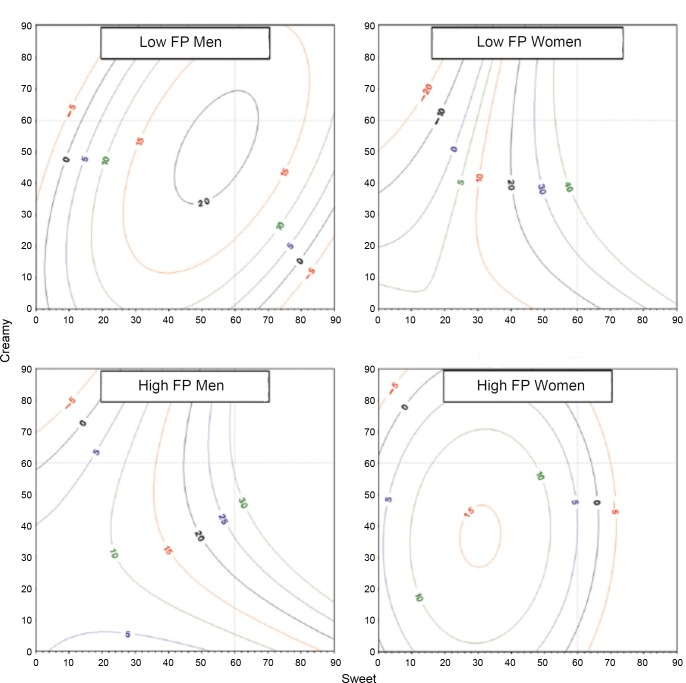Fig. 16.
Sex and the density of fungiform papillae (FP) on the tongue interact to determine human hedonic responses to sweet-creamy flavor mixtures. Combinations of sugar solutions and cream were rated using the general labeled-magnitude-estimation scale, which enables valid comparisons of measurements of subjective experience between groups (e.g., between sexes). Men and women with low and high FP densities were analyzed separately. The x-axes are the sensory intensities (i.e., not hedonic intensities) of the sweetness of the stimuli, and the y-axes are the sensory intensities of their creaminess (0 = no sensation; 100 = the strongest imaginable sensation of any kind); note that the sensory intensities of the stimuli tested ranged from 0 to 90. The pleasantness of the stimuli (−100 = strongest imaginable disliking, 0 = neutral; 100 = strongest imaginable liking) are displayed as isohedonic contours; that is, each line indicates the various sweet-creamy combinations that were judged to have a particular pleasantness, the values of which are given on the contours. Insets on the graphs indicate the range of intensities of pleasantness observed. For example, men who had low FP density found the hedonic intensity of the stimuli to range from approximately −5 to ∼20, with maximum liking (smallest contour area) for stimuli with sensory intensity ∼50 sweet and ∼50 creamy. Note that men with low FP densities and women with high FP densities liked best intermediate sweet-creamy intensities best (maximum liking for men, ∼50 sweet, ∼50 creamy and for women, ∼30 sweet, and ∼40 creamy), but that their degrees of liking were moderate (<25 for men, <20 for women). In contrast, men with high FP densities and women with low FP densities liked higher sweet-creamy intensities best (90 sweet, 90 creamy were most liked by both sexes) and endorsed higher degrees of liking (>30 for men, >40 for women). Note also that flavor mixtures that women with low FP densities liked most (upper right part of graph) were disliked by women with high FP densities. Reprinted from Physiology and Behavior, Oral sensory phenotype identifies level of sugar and fat required for maximal liking, John E. Hayes and Valerie B. Duffy, 95: 77–87, 2008; republished with permission from Elsevier; from Hayes and Duffy (316).

